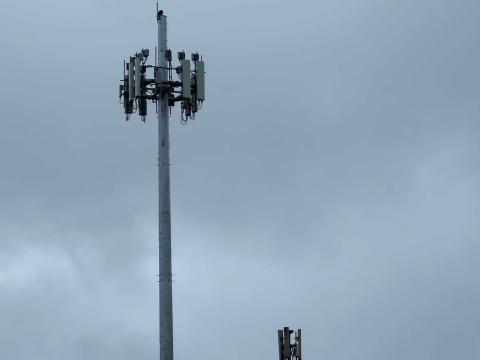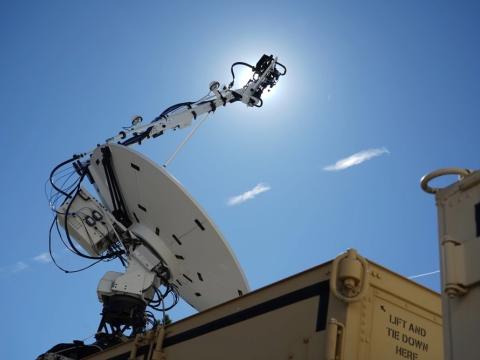Goalkeeper Blocks Incoming Submarine Shots
Prototype underwater interceptor increases warship survivability.
The U.S. Navy is developing a weapon that could someday protect submarines and surface ships from enemy torpedoes. Designed to serve as the last line in a layered defensive system, the device is a specialized small-diameter torpedo that tracks and destroys incoming underwater projectiles.
Modern torpedoes present a considerable threat to ships and submarines. These smart weapons can operate in a number of search patterns to confound evasive maneuvers, or they can actively home in on a vessel’s wake or acoustic signature. The traditional approach to torpedo defense emphasizes diversionary tactics such as noisemakers or towed countermeasure buoys designed to lure weapons off target. Technological advances in computer processing and miniaturization create the possibility for a new family of interceptors that could shield Navy vessels should stealth and subterfuge fail.
Work on the anti-torpedo torpedo (ATT) began in 1987. According to Michael A. Michaels, surface system manager with the Navy’s Undersea Defensive Warfare Systems program, Arlington, Virginia, the project originated from a Navy study investigating new methods to safeguard submarines from torpedo attacks. Research indicated that a layered defensive strategy terminating with a hard-kill ATT capability provided the most robust protection.
Prior to the 1987 study, the only Navy experiments with ATT technology focused on protecting surface ships, Michaels says. A program in the early 1980s used a modified Mark 46 12.75-inch antisubmarine torpedo as an interceptor. He notes that this program ended in 1995 when the weapon failed to perform in operational tests.
Begun at the end of the Cold War, the current ATT program had benefited from generous funding directed at developing new countermeasures, torpedo detection systems and countermeasure launchers. However, the program was halted in 1995 due to high costs, and the remaining funds were used to produce a technology demonstrator before returning to full-scale development, Michaels says.
The Navy adopted a low-risk approach to successfully demonstrate the technology before building a field-capable prototype. The Office of Naval Research is funding the technology demonstration phase of the project with research and development work being conducted by Penn State University’s Applied Research Laboratory, State College, Pennsylvania, and the U.S. Navy Ordinance Laboratory in Indian Head, Maryland. Michaels notes that Penn State’s research has been central to developing major ATT subsystems such as sonar, guidance and propulsion.
The current technology demonstrator is 9.25 feet long and 6.25 inches in diameter. The operational weapon is expected to have the same diameter but measure 8.75 feet in length. The ATT is small because it is designed to fit into a new multipurpose countermeasure launcher currently being installed on U.S. Navy submarines. A modified version of this launcher will be fitted on the surface fleet.
The Navy challenged the research and development community to design an ATT that would fit in the new countermeasures launchers because it did not want to give up limited torpedo space for a defensive weapon, Michaels explains. Navy torpedoes are either 21 inches or 12.75 inches in diameter. Standard submarine-launched torpedoes are 21-inches across, while 12.75-inch weapons are used on some surface ships or are air-delivered. For shipboard use, the ATT will be mounted above the waterline in a canister that serves as both the container and launcher. This simplifies the installation process and eliminates the need for an onboard magazine, he says.
Because many ships such as aircraft carriers do not have sonar capability, the ATT’s fire-control and detection system will be built into the ANSLQ-25A, a towed countermeasure system used by Navy ships. Modifications to the system include an acoustic receiving capability to detect incoming torpedoes and the ability to provide a fire-control solution for an ATT intercept.
The weapon’s small diameter presented design challenges for the power plant and sonar array. Engine power is an important factor in the ATT’s mission because speed and engagement range are important to stop an incoming torpedo.
According to Leo J. Schneider, a research engineer with Penn State’s Applied Research Laboratory, the ATT is propelled by a stored chemical energy propulsion system powered by a lithium and sulfa hexaflouride reaction. The lithium is heated in a boiler, turning a turbine connected to the ATT’s propulsion system. This approach is similar to that of the Navy’s Mark 50 torpedo but engineered on a smaller scale. The Navy uses gasoline to fuel many of its torpedoes such as the Mark 44 and Mark 46. Unlike lithium, hydrocarbon fuels do not provide sufficient energy density for the ATT’s mission, Schneider says. Space limitations continue to pose issues for the program’s engineers, Michaels explains. “We are looking at ways to provide enough power to both run the weapon and put enough acoustic energy in the water to detect a threat weapon.”
The ATT is only the fourth U.S. torpedo to be tested with digital processing, Michaels says. The weapon’s guidance and control section uses a single processor array for directional control, homing and fusing. A multimode seeker and processors create a composite track of the target. The ATT’s designers also drastically reduced the size of the weapon’s safety and arming devices, condensing them from the 117 cubic inches available in a 21-inch torpedo to 13 cubic inches.
Locating an incoming torpedo is difficult because it presents a small, fast maneuvering target that does not produce much noise, Schneider says. Once the ATT is launched, neural networks and fuzzy-logic software allow it to adapt its in-flight behavior to counter different types of torpedo threats such as straight, pattern or wake-homing attacks. After the ATT reaches a predetermined distance from the torpedo, it explodes, destroying or disabling the weapon by concussion.
Wherever possible, the design team used commercially available components to reduce costs. Michaels notes that Penn State’s engineers integrated a number of existing hardware components such as signal processing cards, chips, actuators and an inertial system into the ATT.
The program has not yet reached the stage for full field trials, but in-water tests have resulted in successful interceptions of straight, pattern and wake-homing torpedoes. Michaels is confident these successes are a sign that the program is proceeding on track. “Enough technology has been demonstrated to show that the elements of the subsystems have come together. We are hopefully looking at a successful endeavor,” he says.
Michaels is quick to note that the ATT’s technology still needs to be fully proven before performance and endurance evaluations can begin. Full-scale development is scheduled to begin in the fourth quarter of 2002. The technology demonstration period will continue to run parallel to this stage. This phase will see the construction of a service prototype and testing under operational conditions. Provided the ATT passes its operational evaluations, Michaels expects production and deployment to begin in 2006.




Comments